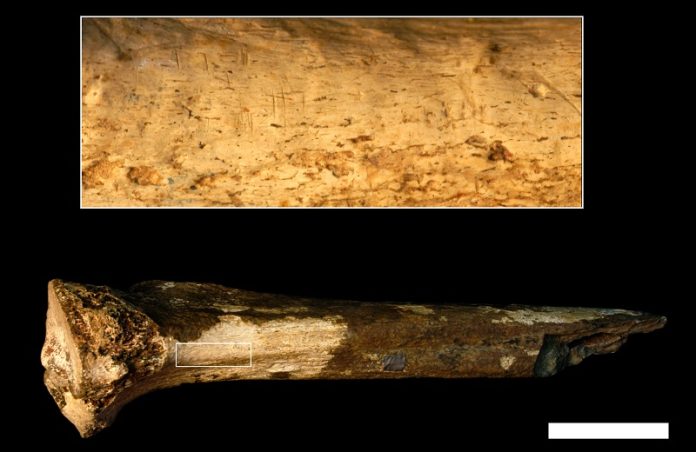
About 1.45 million years ago, ancient humans might have been cannibals, according to a shocking new study from researchers at the Smithsonian’s National Museum of Natural History.
The scientists discovered evidence that humans’ close evolutionary relatives were probably butchering and possibly eating each other.
In a study recently published in Scientific Reports, paleoanthropologist Briana Pobiner and her team described nine cut marks they discovered on an ancient shin bone.
The bone, which belonged to a human relative and is 1.45 million years old, was found in northern Kenya.
By creating 3D models of the fossil, the team concluded that the marks on it were very likely caused by stone tools, suggesting our ancestors may have used tools to butcher each other.
“Our research suggests that hominins, or early humans, were probably eating each other about 1.45 million years ago,” said Pobiner.
“There are other examples of species from our family tree doing this for food, but this fossil tells us that this behavior might have been happening further back in time than we previously thought.”
Pobiner initially discovered the ancient shin bone, or tibia, in the collections of Kenya’s Nairobi National Museum.
She was studying the bone for clues about which prehistoric predators might have hunted humans’ ancient relatives when she noticed marks that seemed like evidence of butchery. To confirm her suspicions, Pobiner sent molds of these cuts to her colleague Michael Pante of Colorado State University.
He scanned the molds in 3D and compared them to a database of different types of marks. His analysis confirmed that nine out of the 11 marks matched the type of damage caused by stone tools. The other two marks were likely bite marks from a large cat, possibly a lion.
The location of the cuts on the bone, where the calf muscle would have been attached, suggests that they were made to remove meat.
While this evidence strongly points towards early humans eating each other for survival, it doesn’t conclusively prove cannibalism, as it’s not clear whether the eater and the eaten were from the same species.
While the fossil bone was first thought to belong to Homo erectus or Australopithecus boisei, today, experts aren’t sure about the exact species. The use of stone tools also doesn’t clarify which species was doing the cutting, as recent research has questioned the assumption that only our genus, Homo, made and used stone tools.
There are also debates about the order of events that led to the bone being cut and bitten. A large cat could have scavenged the remains after hominins had already removed most of the meat, or it might have made the initial kill before being scared away by hominins.
A previous case of potential cannibalism among human relatives involved a skull found in South Africa in 1976. The skull, dated between 1.5 to 2.6 million years old, had marks that some scientists believe were caused by hominins.
However, the origin of these marks is disputed, and it’s also unclear if they were caused by butchering for food.
Pobiner hopes to reexamine the South African skull using the same techniques used in the current study. She emphasizes the importance of museum collections for such discoveries, noting that revisiting old fossils can lead to amazing new insights.
Follow us on Twitter for more articles about this topic.



